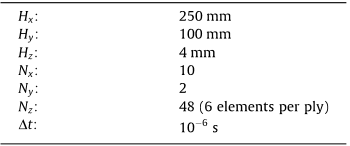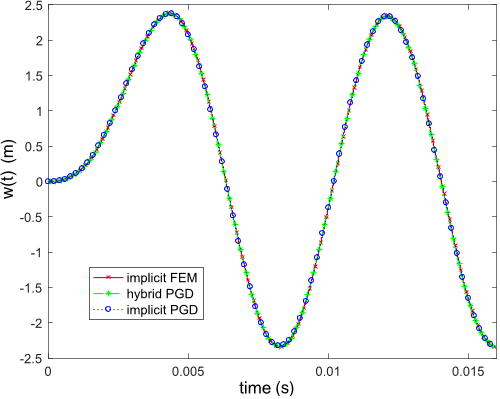Q2. What are the future works mentioned in the paper "A new hybrid explicit/implicit in-plane-out-of-plane separated representation for the solution of dynamic problems defined in plate-like domains" ?
In this paper the authors circumvent such a drawback by using an implicit ( unconditionally stable ) through-the-thickness discretization whereas a standard explicit scheme is considered for treating the in-plane operators.
Q3. What is the main handicap of explicit simulations?
The main handicap of explicit simulations is that the time step must verify the stability condition, decreasing with the element size.
Q4. What is the purpose of the last analysis?
The last analysis aims at taking advantage of the superior stability performances of the implicit formulation, that a priori can use larger time-steps that the ones of explicit and hybrid formulations that are only conditionally stables.
Q5. What is the way to solve dynamic problems?
When dynamics applies on degenerated domains, like plates or shells, and no acceptable simplifying hypotheses are available for reducing their complexity to 2D, fully 3D solutions seem compulsory.
Q6. What is the purpose of this paper?
This paper proposes a new time discretization scheme for solving 3D dynamical problems defined in degenerated domains, that is, domains in which one of its characteristic dimensions is much smaller that the other ones, as it is the case when considering plates or shells.
Q7. What is the appealing route for addressing 3D discretizations?
As discussed in the previous section, with X having one dimension (the one related to the thickness) much smaller than the others involving the in-plane coordinates, an in-plane-out-ofplane separated representation seems again the most appealing route for addressing 3D discretizations while keeping the computational complexity the one characteristic of 2D discretizations.
Q8. What is the main disadvantage of a dynamical analysis and simulation of forming processes?
In many structural analysis and simulation of forming processes dynamical aspects cannot be neglected and then elastic models are replaced by their elastodynamics counterparts.
Q9. How does the mesh determine the limit time-step?
In fact the mesh employed for discretizing the out-of-plane dimension (thickness) determines the limit time-step ensuring stability, and consequently it could become quickly unaffordable when refining the out-of-plane discretization.
Q10. What is the way to solve the problem of elastostatics?
In plane-out-of-plane separated representations, revisited in the next section, allows reducing the 3D solution to a sequence of 2D (in-plane) and 1D (along the thickness) problems, as proved when considering elastostatics in plate and shell domains [5,6].
Q11. What is the main disadvantage of explicit schemes?
On the contrary explicit schemes do not require iteration as the nodal accelerations are solved directly, and from which velocities and displacements are calculated by simple integration.
Q12. What was the route used for deriving beam, plate and shell theories in solid mechanics?
This was the route employed for deriving beam, plate and shell theories in solid mechanics, that were extended later to many other physics, like flows in narrow gaps, thermal or electromagnetic problems in laminates, among many others.
Q13. How many meshes are used in the analysis?
For each mesh the authors compare the computing time employed by both the hybrid and the fully implicit PGD discretizations to solve the problem in the time interval ½0;400Dt , with the time-step Dt ¼ 10 53 s for all the simulations.
Q14. How do the authors compare the three PGD formulations?
the authors perform a comparison between the three PGD formulations (explicit, hybrid and implicit) in the time interval ½0;400Dt , with Dt ¼ 10 7 s to ensure the stability of the explicit time integration.





